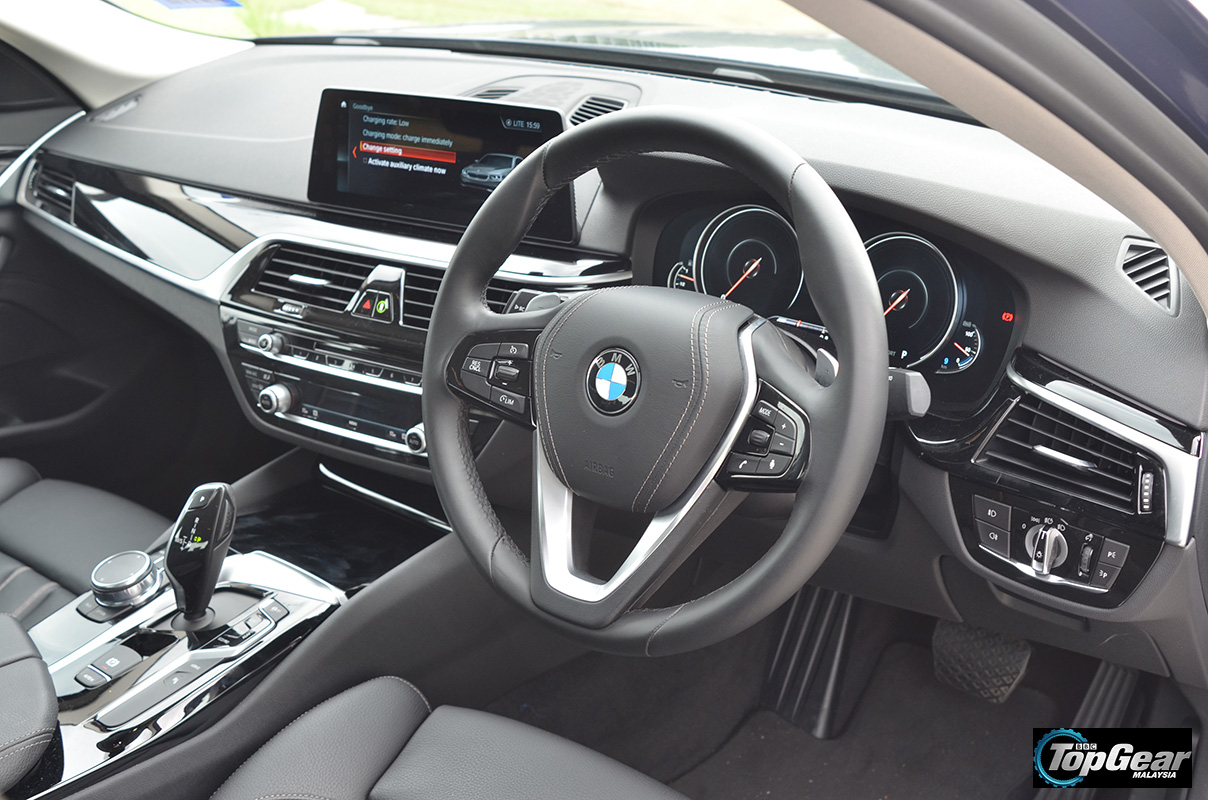Test drive: BMW 530e iPerformance
It started with a hiss. Most plugin hybrids do, if you listen closely. But of all the premium, chargeable cars available in Malaysia at tax discounted prices, BMW’s iPerformance models have a knack of edging it in electric refinement from the moment you hit the start button to the second the combustion engine kicks in with much reluctance.
The 530e is no different. As long as its battery levels permit, the plugin 5-er prefers roleplaying as an EV (electric vehicle), and a good one at that. On paper, this is doable up to 140kph, with the claimed range being 48km on a full charge. Real-world limits aren’t as lofty, but managing a sub-20km school run without triggering the two-litre turbo is entirely possible under civil driving conditions.
This frustrated the Bimmer enthusiast within us at times. Driving a 5-Series is supposed to be a fulfilling, sporty occasion. But until a heavy-footed assault on the accelerator wakes the engine up, the throttle feels uncharacteristically blunt. You could override this by changing the driving mode to Sport, but not without a tinge of guilt. It’s like having a quinoa salad while on a diet only to wash it down with a sundae float.
Should you be defeated by your cravings, hitting the Sport button sharpens the 530e’s throttle response and transmission urgency, not that the ZF shift wouldn’t already be good to begin with. Despite having two inputs to juggle, the tried and tested 8-speeder puts on a stellar performance no matter what the driving mode. In fact, it imbues the 530e with a mechanical refinement we’d be happy to have in a 7-Series.
With Sport mode on, the 8-speeder makes great use of the combined 252bhp and 420Nm output to give the 530e a touch more zest in a straight line over the 530i, though they have matching century sprint times of 6.2 seconds. The 530e’s Dynamic Damper Control is supposed to tighten up the ride to match the able powertrain, but the suspension is a few wisps shy of its petrol-only twin’s overall stability. The fact that the high-voltage bits weigh an extra 155kg may have something to do with it.
For that reason – and some others – the 530i remains the go-to G30 for buyers who want a driver-oriented 5-er. Sure, the 530e has a 70Nm advantage that shows on the straights, but its maximum output is only good for as long as the 9.2kWh battery is sufficiently charged to keep the 84kW motor running. Dry it out and you’re left with 184bhp and 290Nm, which is basically what you’d get from a 520i. It still supplies decent levels of grunt, but there are times when the engine sounds strained from keeping the rear wheels spinning while simultaneously recharging the battery on the move like a conventional hybrid.
Because we didn’t have regular access to a charging station, we found ourselves driving this way half the time by engaging Battery Control mode to ensure we were never completely starved of electricity. One of three eDrive modes – the others being Auto eDrive and Max eDrive – Battery Control lets the driver set a minimum charge level to preserve for later use, which is especially useful for condo dwellers in the Klang Valley. Useful but not ideal.
Assigning the responsibility of charging to the engine hampers fuel efficiency significantly. We managed a little over 8L/100km on the combined cycle this way, which isn’t bad per se. But it’s over four times the published 2L/100km, which you’re better off trying to replicate with regular charging from the grid. Local dealerships sell a BMW i Wallbox that can fully charge a 530e in under three hours. Charging via a standard three-pin socket takes about five hours, which is still viable if you can do it in the porch of your home.

Maximising the wide breadth of talents of an upmarket PHEV like the 530e takes a bit of effort. But even the laziest and most traditional of drivers might be compelled to purchase one over a 530i on the basis of price alone. Despite packing a cleverer powertrain, the 530e is RM45k cheaper thanks to tax incentives favouring locally assembled, energy efficient vehicles (EEV). That said, you do lose out on some neat kit present in the 530i.
Among the features sacrificed are adaptive LED headlights, Gesture Control system, BMW Display Key, a 16-speaker Harman Kardon and a sunroof. Most of them are novelties you can afford to live without, so the base German exec that drives well and rides comfortably is still in the bag whichever way you shop. However, it’s worth noting the 530e’s battery takes up 120 litres of boot volume, leaving a 410-litre compartment that’s still functional, but not very welcoming to hefty golf bags.
So while the 530e is one of the best plugin hybrid saloons on sale today in value, driveability and refinement, it isn’t necessarily the best 5-Series money can buy. The future may be electric, but the choice of revelling in the petrol fumes of the present is still yours to make.
OR TRY THIS: Mercedes-Benz E350e
Unlike the Bimmer, Merc’s plugin saloon is positioned as the range-topper, with the bling to match
Quiet, efficient and refined, this is electrification done right. However, some dynamic trade-offs mean the 530i is still relevant in our market.
SPECS
| Engine | 1,998cc 4-cylinder turbo, 84kW electric motor, 252bhp, 420Nm (combined) |
| Price | RM343,888 |
| Performance | 0-100kph in 6.2 secs, 235kph |
| Economy | 2.0L/100km, 46g/km CO2 |
| Weight | 1,765kg |

